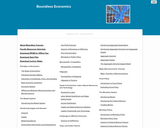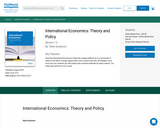
Charts related to the latest "Consumer Price Index" news release.
- Subject:
- Economics
- Social Science
- Material Type:
- Diagram/Illustration
- Provider:
- Bureau of Labor Statistics
- Date Added:
- 08/21/2023

Charts related to the latest "Consumer Price Index" news release.

The American statesman Benjamin Franklin (1706–1790) once wrote: “No nation was ever ruined by trade.” Many economists would express their attitudes toward international trade in an even more positive manner. The evidence that international trade confers overall benefits on economies is pretty strong. Trade has accompanied economic growth in the United States and around the world. Many of the national economies that have shown the most rapid growth in the last few decades—for example, Japan, South Korea, China, and India—have done so by dramatically orienting their economies toward international trade. There is no modern example of a country that has shut itself off from world trade and yet prospered. To understand the benefits of trade, or why we trade in the first place, we need to understand the concepts of comparative and absolute advantage.

The Bureau of Economic Analysis (BEA) produces two measures of national output which, in theory, should be equivalent. In practice, however, there are often substantive differences.

This catalog contains educational content originally curated by Boundless. In collaboration with the Boundless team, Lumen Learning imported these OER courses to the Lumen Platform, to ensure they remain freely available to the education community after Boundless ceased operations. Lumen maintains the Boundless content in the same condition it was provided to us. Courses may contain issues with formatting, accessibility, and the degree to which content remains current, accurate, and complete.

Official website of the United States Bureau of Economic Analysis.

The official website of the United States Bureau of Labor Statistics.

The most common way to calculate the correlation coefficient (r) is by using technology, but using the formula can help us understand how r measures the direction and strength of the linear association between two quantitative variables.

The most common way to calculate the correlation coefficient (r) is by using technology, but using the formula can help us understand how r measures the direction and strength of the linear association between two quantitative variables.

Widespread media reports of local teacher shortages have become a hot topic in education since the summer of 2015. After years of teacher layoffs, districts began hiring again as the economy recovered from the Great Recession. Many were surprised to find they had serious difficulty finding qualified teachers for their positions, especially in fields like mathematics, science, special education, and bilingual education/English language development. A number of states greatly expanded emergency permits to allow hiring of untrained teachers to meet these demands—which is the classic definition of shortage. To date, however, there has not yet been a detailed national analysis of the sources and extent of these shortages, and the prognosis for the future.

Overview of Communism and Marxist-Leninist states. For extra coverage of the Cold War outside the scope of the AP course, click here. Created by Sal Khan.

It is common to use GDP as a measure of economic welfare or standard of living in a nation. When comparing the GDP of different nations for this purpose, two issues immediately arise. First, the GDP of a country is measured in its own currency: the United States uses the U.S. dollar; Canada, the Canadian dollar; most countries of Western Europe, the euro; Japan, the yen; Mexico, the peso; and so on. Thus, comparing GDP between two countries requires converting to a common currency. A second issue is that countries have very different numbers of people. For instance, the United States has a much larger economy than Mexico or Canada, but it also has roughly three times as many people as Mexico and nine times as many people as Canada. So, if we are trying to compare standards of living across countries, we need to divide GDP by population.

In this episode of the Economic Lowdown Video Series, economic education specialist Scott Wolla explains the concept of demand. Viewers will learn how a change in the price of a good affects the quantity of the good consumers will buy and how changes in market conditions affect the demand for a good.

Federal tax and spending policies can affect the economy through their impact on federal borrowing, private demand for goods and services, people’s incentives to work and save, and federal investment, as well as through other channels. CBO analyzes the economic effects of federal fiscal policies in current law as well as significant proposed changes in those policies.

The text focuses throughout on evidence on the economy, from around the world, and from history. It is motivated by questions—how can we explain what we see? The method is to ask interesting questions first and then to introduce models that help to answer them. Standard tools such as constrained optimization are taught by showing how they give insight into real-world problems. Economics as a discipline is set in a social, political, and ethical context in which institutions matter.

Arnold Kling joins us to talk about his new book, Specialization and Trade, which was recently published by Libertarianism.org.
What’s the “MIT” approach to economics, and what’s wrong with it? Is economics a hard science? What is an economic model? What are some of the problems with thinking of the world this way?
Arnold Kling claims that the economy isn’t like one big machine with a single purpose that can be fine tuned and regulated by experts. In this week’s episode, he presents an alternate way of thinking about economics, one you won’t find being taught in most college classrooms.

In this episode of the Economic Lowdown Video Series, economic education specialist Scott Wolla explains the concept of equilibrium. Viewers will get a refresher on the laws of supply and demand before they learn about market equilibrium – the point at which there is no shortage or surplus of a good or service.

GDP is like a speedometer: it tells you whether your economy is going faster or slower. As in cars, a speedometer is useful but doesn’t tell you everything you want to know. For example, it won’t tell you whether you are overheating, or about to run out of fuel.

Here’s the third chapter of our mini-series on business cycle theories: The Real Business Cycle.

When workers are unemployed, they, their families, and the country as a whole lose. Workers and their families lose wages, and the country loses the goods or services that could have been produced. In addition, the purchasing power of these workers is lost, which can lead to unemployment for yet other workers.
Addressing the issue of unemployment requires information about the extent and nature of the problem. How many people are unemployed? How did they become unemployed? How long have they been unemployed? Are their numbers growing or declining? Are they men or women? Are they young or old? Are they White, or Black, or Asian, or of Hispanic ethnicity? How much education do they have? Are they concentrated in one area of the country more than another? These statistics—together with other economic data—can be used by policymakers to determine whether measures should be taken to influence the future course of the economy or to aid those affected by joblessness.

International Economics: Theory and Policy is built on Steve Suranovic’s belief that students need to learn the theory and models to understand how economics works and how economists understand the world. And, that these ideas are accessible to most students if they are explained thoroughly.
So, if you are looking for an International Economics text that will prepare your PhD students while promoting serious comprehension for the non-economics major, Steve Suranovic’s International Economics: Theory and Policy is for you.
International Economics: Theory and Policy presents numerous models in some detail; not by employing advanced mathematics, but rather by walking students through a detailed description of how a model’s assumptions influence its conclusions. Then, students learn how the models connect with the real world.
Steve’s book covers positive economics to help answer the normative questions; for example, what should a country do about trade policy, or about exchange rate policy? The results from models give students insights that help us answer these questions. Thus, this text strives to explain why each model is interesting by connecting its results to some aspect of a current policy issue.
This text eliminates some needlessly difficult material while adding and elaborating on other principles. For example, the development of the relative supply/demand structure, or the presentation of offer curves, are omitted as to not go too deeply into topics that tend to confuse many students at this level.
Steve developed new approaches in this text including a simple way to present the Jones’ magnification effects, a systematic method to teach the theory of the second best, and a unique description of valid reasons to worry about trade deficits. These new approaches help students learn the concepts and models and derive conclusions from them.
If you like to take a comprehensive look at trade policies, be sure to check out the chapter on Trade Policy (7). It provides a comprehensive look at many more trade policies than are found in many of the printed textbooks on the market today.
International Economics: Theory and Policy by Steve Suranovic is intended for use in a full semester trade course, a full semester finance course, or a one semester trade/finance course.